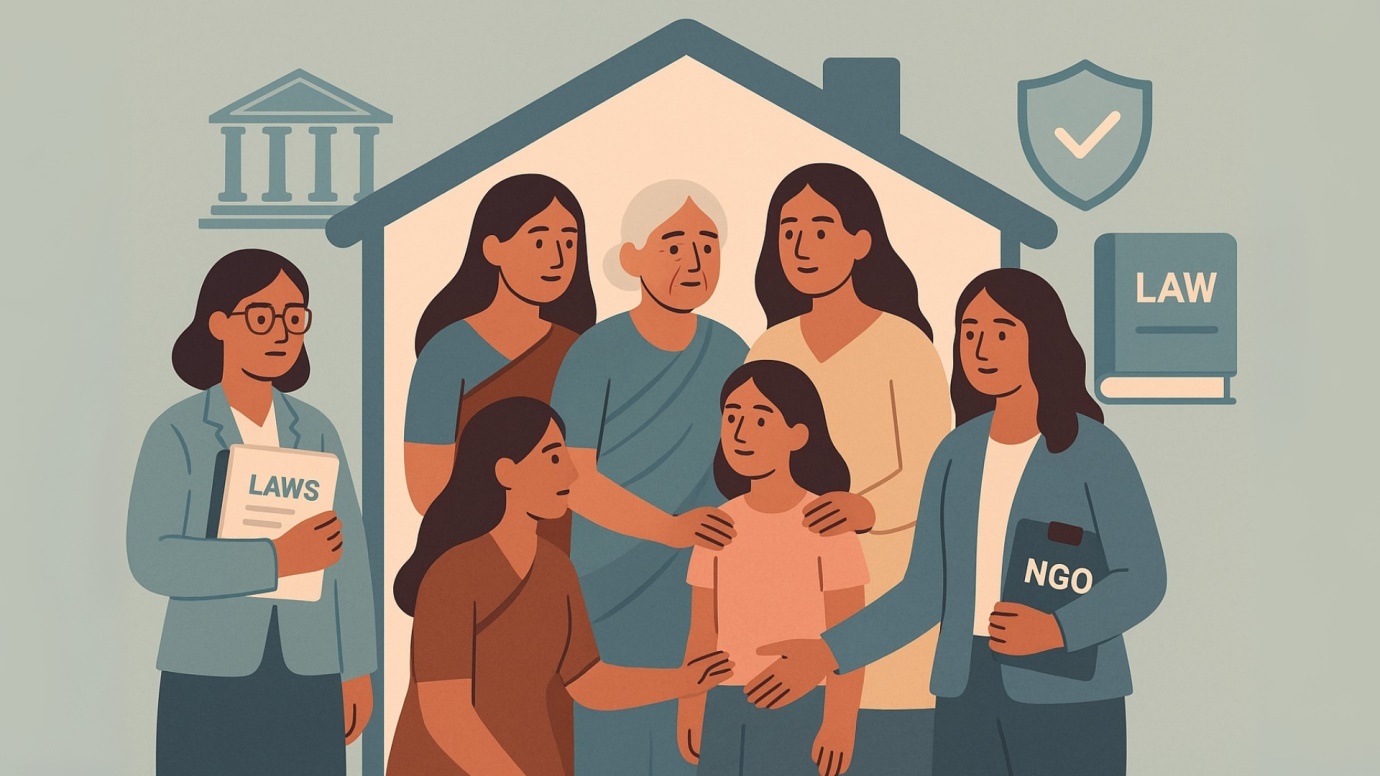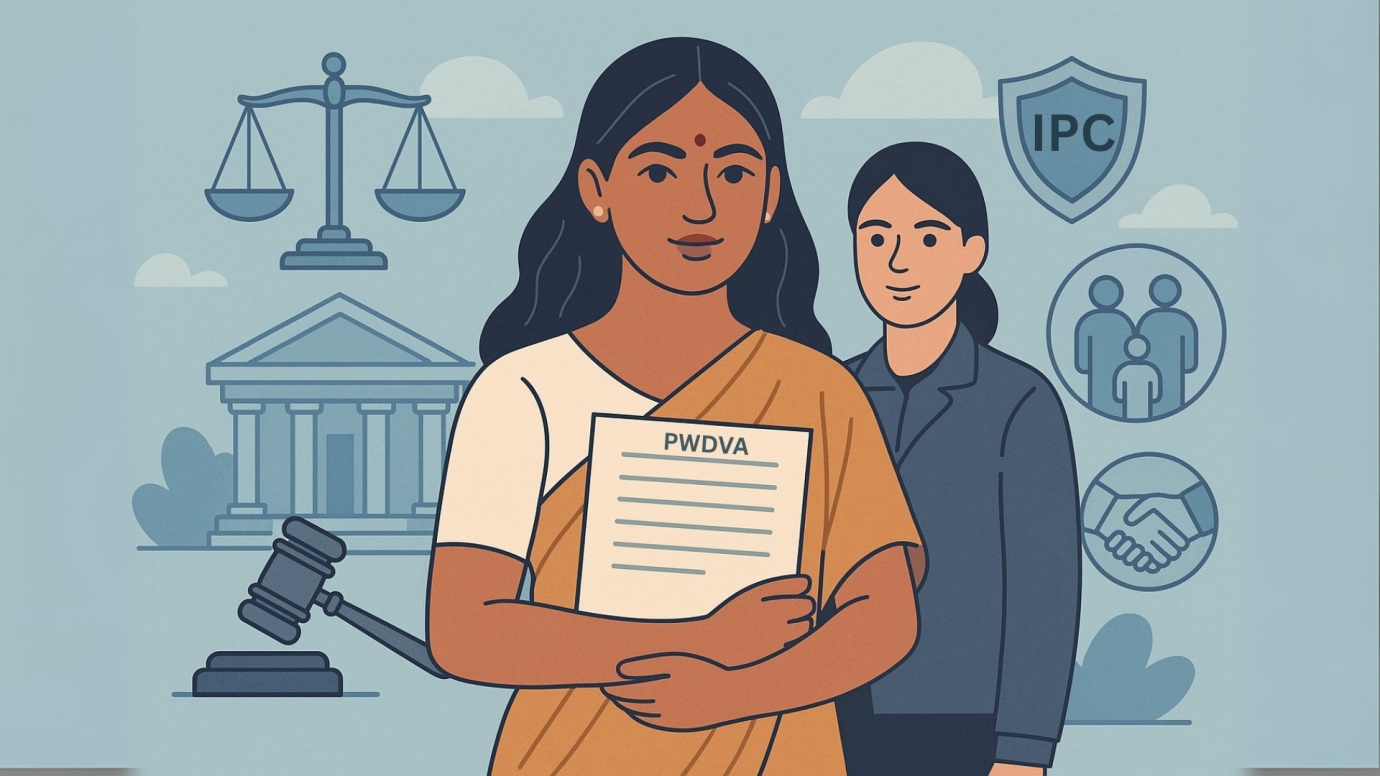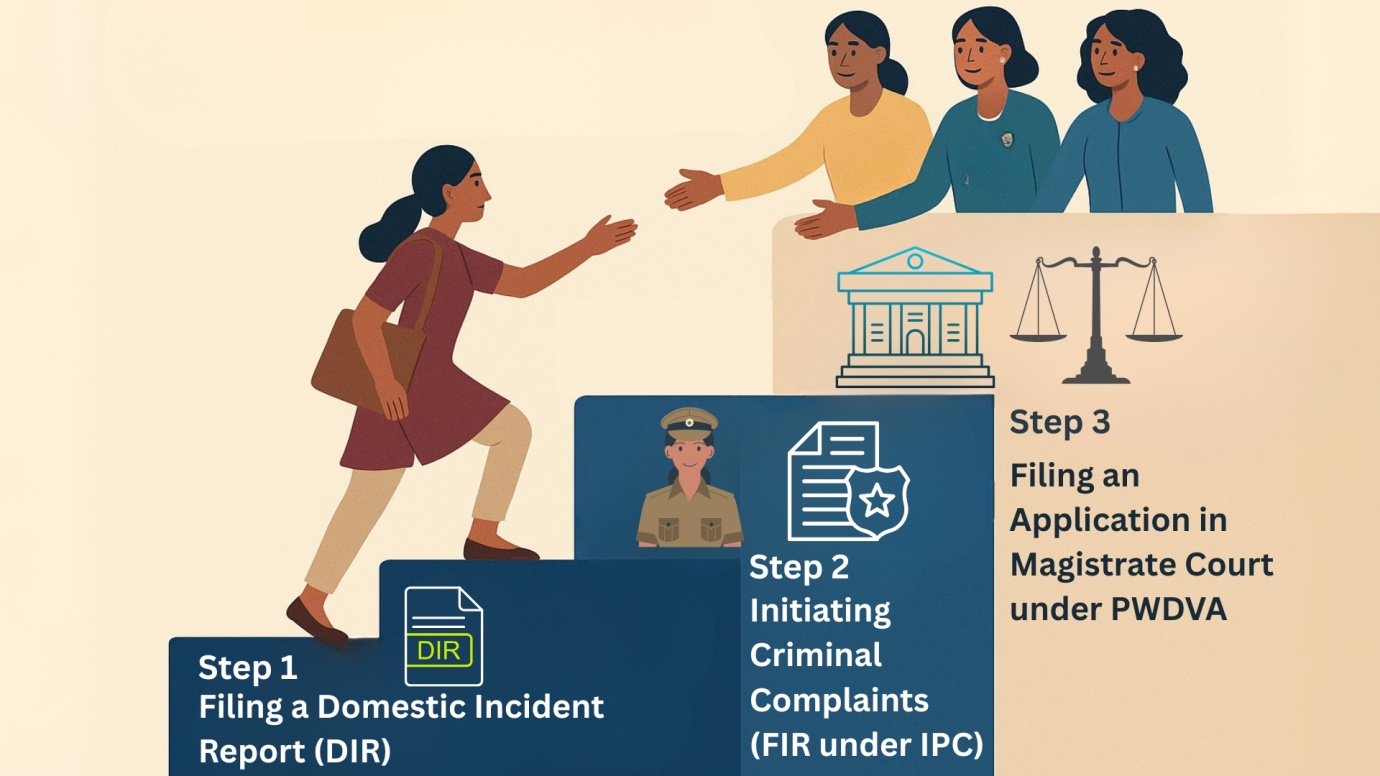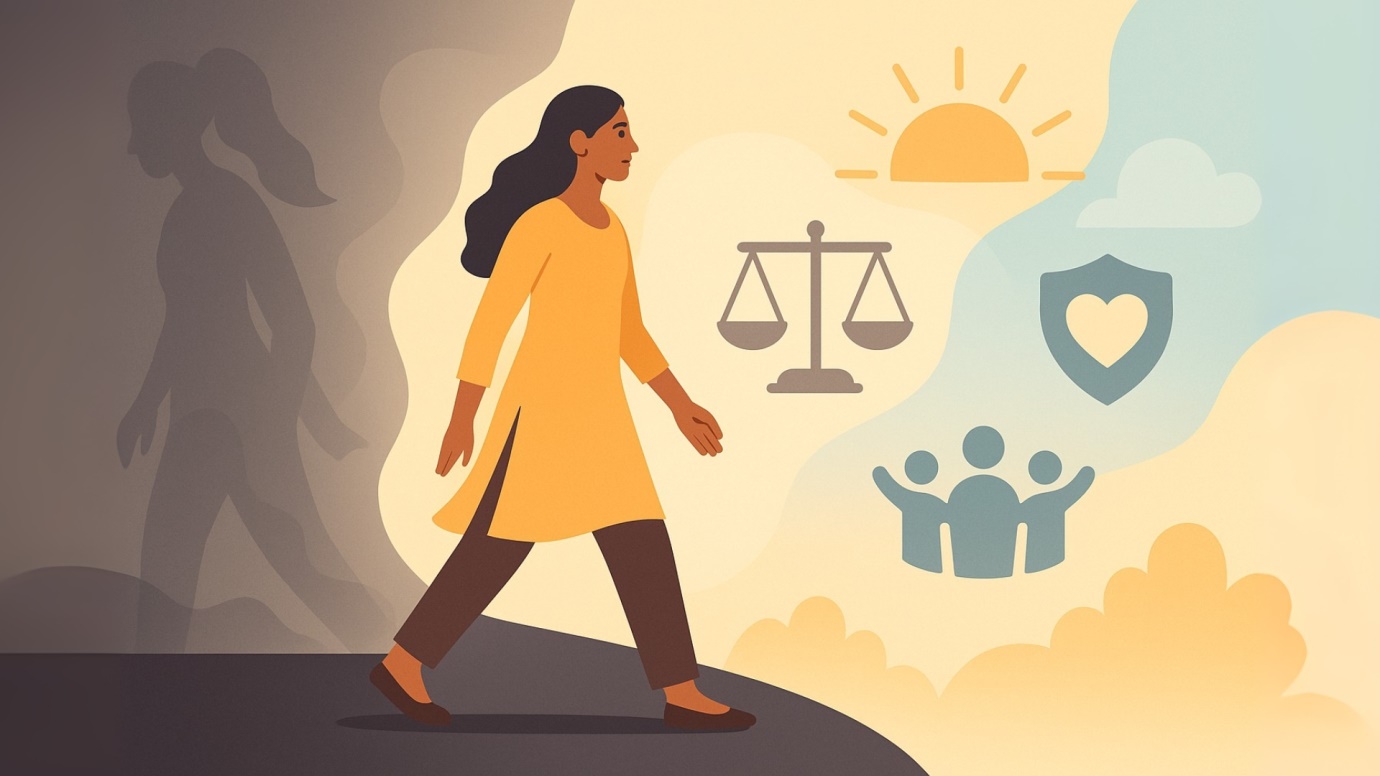What the Law Says About Domestic Violence — & How You Can Protect Yourself
Domestic violence continues to be a serious social and human rights issue in India, affecting individuals across all ages, backgrounds, and communities. Despite growing awareness and evolving laws, many domestic violence cases still go unreported due to fear, stigma, or lack of access to support systems.
In India, domestic violence is not limited to physical harm. It includes emotional, verbal, sexual, and economic abuse occurring within households—often inflicted by spouses, partners, in-laws, or even other family members. These patterns of abuse are more than isolated incidents; they represent systemic control and coercion in the most intimate settings.
Recent domestic violence statistics published by the National Crime Records Bureau (NCRB) show a disturbing rise in reported cases, particularly during lockdown periods when victims had limited mobility and access to help. According to reports, thousands of women across urban and rural India continue to face abuse behind closed doors, despite legal protections in place.
A particularly concerning aspect of this issue is domestic violence during pregnancy, where physical or psychological harm not only endangers the woman but also puts her unborn child at risk. Studies and health surveys have highlighted the long-term impact of such abuse on maternal and infant health, making it a critical area of concern for both public health and human rights advocates.
Understanding the nature of domestic violence, how it manifests, and the broader implications on society is essential for creating a culture of accountability and support. While laws exist to offer protection, awareness and timely action remain the first lines of defense in addressing this widespread problem.

Defining Domestic Violence under Indian Law
In the Indian legal context, a domestic violence case is not limited to physical assault—it includes a much broader range of abusive behaviors that are meant to control, intimidate, or harm a person in a domestic setting. Recognizing the need for comprehensive protection, the Indian government enacted the Protection of Women from Domestic Violence Act, 2005 (PWDVA), a civil law focused on safeguarding the rights and dignity of women.
Under the PWDVA, the law defines domestic violence as any act, omission, or conduct that causes harm or injury to a woman’s physical, mental, sexual, emotional, or economic well-being. It explicitly recognizes various forms of abuse:
- Section 498A: Addresses cruelty by a husband or his relatives, including physical harm and dowry-related abuse.
- Sections 323 & 324: Deal with causing hurt and grievous hurt, relevant in cases of physical assault.
- Section 354: Covers assault or criminal force intended to outrage a woman’s modesty.
- Section 376: Defines rape, although marital rape is currently exempt if the wife is above a certain age.
Recognizing the signs of domestic abuse is a crucial part of the legal process. Frequent unexplained injuries, emotional withdrawal, financial dependency, and fear of one’s partner are all indicators that may support a domestic violence case. Early identification of such patterns can empower victims to seek help and protection under the law.
Although the PWDVA is a civil law, it operates in conjunction with these criminal provisions to provide both relief and legal consequences for abusive behavior. It is designed not just to punish but to protect, offering victims access to safe housing, financial support, and psychological security.
Understanding how Indian law defines and responds to domestic battering and abuse helps clarify the seriousness with which the legal system approaches these issues. However, legal definitions must always be interpreted through proper legal channels, and anyone facing or witnessing abuse is encouraged to seek formal support through designated authorities.
Who is Protected & Who Can File a Complaint?
Understanding who is legally protected under Indian law is crucial to addressing and responding to a domestic violence case. The Protection of Women from Domestic Violence Act, 2005 (PWDVA) extends its scope beyond just married women, recognizing the complex dynamics of domestic abuse in various household arrangements.

Who is Protected Under Indian Law?
The PWDVA is primarily designed to protect women who are in a domestic relationship, which includes more than just traditional marriage. The term “domestic relationship” has been defined broadly to offer protection in various contexts.
Protected relationships include:
- Wives in legal marriages
- Women in live-in relationships
- Mothers, sisters, daughters, or other female relatives in a shared household
- Divorced or separated women still residing in or affected by the shared household
This broad definition ensures that women experiencing domestic abuse — whether from a spouse, partner, or even other family members — are eligible for support and protection under the law.
The law acknowledges that domestic violence isn’t always limited to spousal abuse. It can be inflicted by in-laws, siblings, or any other person in a domestic relationship who exercises control, causes harm, or restricts autonomy.
Who Can File a Complaint?
A woman experiencing domestic violence can file a complaint herself, or through:
- A Protection Officer appointed by the government
- Any relative or friend acting on her behalf
- A registered NGO or service provider
- A medical professional or social worker aware of the abuse
- The woman’s guardian or caregiver, if she is a minor or mentally ill
These flexible provisions recognize the barriers many women face in reporting domestic violence cases, such as fear, trauma, social pressure, or dependency.
Role of Protection Officers and NGOs
Protection Officers play a critical role in ensuring timely support for women facing domestic abuse. Their responsibilities include:
- Assisting the woman in filing a Domestic Incident Report (DIR)
- Helping access medical care, legal aid, and safe shelter
- Guiding victims through the process of obtaining protection orders
- Presenting applications before the Magistrate on behalf of the woman
Alongside them, NGOs and women’s support organizations provide crucial assistance such as:
- Counseling and emotional support
- Temporary accommodation or shelter homes
- Help with documentation and legal awareness
- Connecting survivors to legal aid clinics or police authorities
These support systems aim to create a safer, more approachable path for women to step forward and take action in a domestic violence case.
Legal Remedies Available for Domestic Violence in India
If someone is facing a domestic violence case, Indian law provides both civil and criminal remedies that aim to ensure safety, protection, and justice. These remedies are structured under two major legal frameworks — the Protection of Women from Domestic Violence Act, 2005 (PWDVA) and relevant provisions of the Indian Penal Code (IPC).
These laws offer a wide range of options to address domestic abuse punishment, provide emergency relief, and deter further harm.

A) Civil Remedies Under PWDVA, 2005
The PWDVA was designed to offer quick and accessible protection to women without necessarily initiating a criminal case. These are non-penal yet powerful tools that safeguard survivors of abuse.
Key Civil Remedies:
- Protection Orders: Prevents the abuser from committing any further acts of domestic violence, entering the victim’s residence or workplace, or communicating in threatening ways.
- Residence Orders: Grants the woman the right to continue living in the shared household, regardless of ownership or title.
- Monetary Relief: Covers medical expenses, loss of income, and costs incurred due to the abuse. It helps ease financial dependency.
- Custody Orders: Temporary custody of children can be granted to the woman if it ensures safety and welfare.
- Compensation Orders: Victims may receive compensation for mental trauma, emotional distress, and other harm caused by abuse.
Additional Civil Support:
- Free legal aid via NALSA (National Legal Services Authority) and State Legal Services Authorities
- Access to shelter homes, medical aid, and counseling centers
While these remedies do not carry penalties for domestic violence themselves, violating a protection or residence order can lead to criminal prosecution.
B) Criminal Remedies Under Indian Penal Code (IPC)
In more serious or violent situations, the survivor may pursue criminal charges that can result in arrest, trial, and punishment. Criminal charges can lead to a punishment for domestic violence including jail time, fines, or both, depending on the severity of the offense.
Relevant IPC Sections:
- Section 498A: Addresses cruelty by a husband or in-laws, often related to physical abuse or dowry harassment. It is a key tool in many domestic violence cases.
- Section 323 / 324: Punishes causing hurt or grievous hurt. These are applicable when physical harm is inflicted.
- Section 354: Deals with assault or criminal force intended to outrage a woman’s modesty — relevant in sexual and emotional abuse scenarios.
- Section 376: Covers rape. While marital rape is not yet fully criminalized, if the wife is under 15, it qualifies as a punishable offense.
Possible Criminal Penalties:
- Punishment for domestic abuse may range from short-term imprisonment to several years, depending on the section applied.
- Penalty for domestic violence can include fines, legal costs, or financial compensation to the victim.
- Offenders may face domestic assault penalties, including domestic violence fines imposed by the court.
- Repeat or severe offenders may receive longer domestic violence punishment or even extended imprisonment under domestic violence penalties
While these remedies exist to ensure justice and protection, the process can be emotionally and mentally demanding. Having the support of the best domestic violence attorney can help survivors navigate legal procedures more confidently and ensure their rights are properly represented.
It’s important to remember that each domestic violence case is unique, and the decision to pursue civil or criminal remedies—or both—depends on the circumstances, severity of abuse, and the safety of the survivor.
Procedure to Seek Legal Protection
Navigating a domestic violence case can be overwhelming, especially when someone is dealing with fear, trauma, or lack of support. However, India’s legal system offers multiple pathways for survivors to seek protection, security, and justice. Understanding the procedure to initiate action—both civil and criminal—can empower individuals to take the first step toward safety.

Below is a step-by-step breakdown of how to begin the legal process in cases of domestic violence.
Step 1: Filing a Domestic Incident Report (DIR)
The first step in most civil cases under the Protection of Women from Domestic Violence Act, 2005 (PWDVA) is to file a Domestic Incident Report (DIR). This document captures details of the abuse and can be filed by:
- The survivor herself
- A Protection Officer
- A relative, friend, or NGO representative acting on her behalf
The DIR serves as an official record of the domestic violence case and is submitted to the Magistrate’s court for further action. It is also shared with the police and service providers to coordinate emergency response and support services.
If you’re unsure how to proceed, reaching out to a Protection Officer or a local legal aid clinic can guide you through the process.
Step 2: Initiating Criminal Complaints (FIR under IPC)
If the abuse involves criminal behavior such as assault, cruelty, or sexual violence, the survivor may file a First Information Report (FIR) at the nearest police station.
Applicable IPC sections may include:
- Section 498A for cruelty by husband or relatives
- Section 323/324 for causing hurt or grievous hurt
- Section 354 for sexual harassment
- Section 376 for rape (note: marital rape is partially exempted)
Once an FIR is filed, the case enters the criminal justice system. If convicted, the accused may face imprisonment, fines, or both. This process can result in a sentence for domestic assault, depending on the severity of the offense and the evidence presented.
Step 3: Filing an Application in Magistrate Court under PWDVA
Simultaneously or independently of a criminal complaint, a woman can file an application under PWDVA in the local Magistrate’s Court. This application may request:
- Protection orders
- Residence orders
- Monetary compensation
- Child custody arrangements
The court may call for a hearing and issue interim relief to ensure the safety of the survivor. The Protection Officer plays a key role in assisting with filing the application, gathering evidence, and presenting the Domestic Incident Report to the court.
How You Can Protect Yourself from Domestic Violence
Facing domestic violence is emotionally, physically, and mentally exhausting — but understanding your options and being prepared can make a powerful difference. While laws in India aim to offer protection and justice, your personal preparedness and awareness can strengthen your ability to respond in a crisis. Below are practical, non-legal steps you can take if you or someone you know is facing abuse.

Legal Preparedness: Start by Documenting Abuse
Keeping a record of incidents is a vital first step in protecting yourself in a domestic violence case. Even if you’re not ready to take immediate action, documentation can serve as valuable evidence later.
- Maintain a diary or digital record of dates, times, and nature of abuse.
- Photograph injuries or damage to belongings, if safe to do so.
- Save threatening messages from texts, social media, or emails.
- Inform a trusted friend, neighbor, or family member who can verify your experience if needed.
This evidence can be especially important if the situation escalates to criminal charges, which may result in domestic violence jail time or other penalties for the abuser.
Leverage Civil Remedies under PWDVA
The Protection of Women from Domestic Violence Act (PWDVA) provides civil protections without requiring immediate criminal prosecution.
Through the help of a Protection Officer or a support organization, you can seek:
- Protection orders to stop further abuse
- Residence orders that allow you to stay in the shared household
- Monetary relief for expenses or loss of income due to domestic violence
Although the process is civil, violating these orders can have serious consequences, potentially leading to domestic violence prison time for the offender.
Pursue Criminal Charges When Applicable
In cases involving physical harm, threats to life, or sexual assault, you may choose to initiate criminal proceedings under the Indian Penal Code (IPC).
This can involve:
- Filing a First Information Report (FIR) at the nearest police station
- Citing IPC sections like 498A (cruelty), 323/324 (hurt), or 376 (rape)
Successful prosecution may lead to domestic abuse jail time, domestic assault jail time, or extended domestic violence jail time based on the severity of the charges.
While initiating a criminal case is a serious decision, it can also act as a strong deterrent and offer long-term protection.
Free Legal Support: Tap Into National and Local Resources
Legal help doesn’t have to be expensive. If you’re unable to afford private legal services, you can seek free legal aid through:
- National Legal Services Authority (NALSA) and State Legal Services Authorities
- One-Stop Centers for women, available in many districts
- Women’s helplines (e.g., 181) and government-funded NGOs
While private representation may give you added support — especially if working with the best domestic violence attorney available in your area — free services are designed to ensure no woman is left without access to justice.
Safety Planning: Be Prepared for Emergency Exit
Whether you decide to stay or leave, a safety plan gives you the power to act quickly and decisively.
Here are simple steps to prepare:
- Keep essential documents (ID, medical records, bank papers) ready in one place
- Save emergency contacts — family, friends, shelters, and local police
- Secure some emergency funds, even if small
- Have an escape plan, including where you can go if you need to leave quickly
- If possible, store copies of records and contact info digitally and securely
Protecting yourself from domestic violence is not just about legal steps — it’s about reclaiming your safety, dignity, and autonomy. Whether you seek protection through civil remedies, pursue criminal charges that may lead to domestic abuse jail time, or simply plan for emergencies, being informed is your first line of defense.
Limitations & Challenges in Addressing Domestic Violence
While legal frameworks like the Protection of Women from Domestic Violence Act, 2005 (PWDVA) and provisions under the Indian Penal Code (IPC) exist to address abuse, several practical and social challenges still hinder the effective resolution of a domestic violence case in India.
Despite the seriousness of the issue, survivors often face significant barriers in seeking justice and protection. These limitations impact the ability of the law to deliver swift and meaningful relief.
Implementation Gaps on the Ground
One of the most pressing challenges lies in the implementation of existing laws. While the legal language is robust, the infrastructure supporting victims is often weak.
Key concerns include:
- Low public awareness: Many victims do not understand their rights or the available remedies in a domestic violence case.
- Inconsistent training for Protection Officers: Officers may lack the sensitivity or legal knowledge required to respond effectively.
- Limited accessibility to services: Shelter homes, medical aid, and counseling centers are not evenly distributed, especially in rural areas.
- Delayed response from law enforcement: Victims often report apathy, delayed action, or lack of seriousness from police personnel.
These factors can make it extremely difficult for victims to pursue civil protections or initiate criminal charges — even in severe cases of domestic battering.
Marital Rape Not Fully Criminalized
A major gap in the legal landscape is the non-criminalization of marital rape. Under current Indian law, marital rape is not considered a crime if the wife is above the age of 15. This legal exemption creates a serious contradiction, as sexual abuse within marriage can still cause psychological, physical, and emotional harm.
Victims of such abuse can only seek civil relief through PWDVA — such as protection orders or residence orders — but no criminal penalties can be imposed unless other charges like cruelty or assault are applicable.
This means that even severe forms of domestic battering or forced sexual relations in marriage may go unpunished under the Indian Penal Code, leaving survivors with limited legal recourse.
Gender-Specific Protections and Emerging Debates
The PWDVA is currently designed to protect only women in domestic relationships. While this focus addresses the disproportionate number of female victims, it excludes male and LGBTQ+ survivors of domestic violence, creating a new layer of legal inequality.
Emerging debates are challenging this approach, with advocacy groups demanding broader, gender-neutral laws that recognize:
- Male victims of domestic violence
- Abuse in same-sex relationships
- Situations where women may be the perpetrators
In cases involving male survivors, terms like domestic battery meaning or definitions under the law do not offer the same protections, leaving many without legal remedy or social support.
While these challenges persist, they are also shaping conversations around legal reform, improved enforcement, and inclusive policy-making. Public education, better resource allocation, and updated legislation are essential to ensure that justice is not just written in law but delivered in practice.
FAQs
A. Domestic violence in India includes physical, emotional, sexual, verbal, and economic abuse by a partner or family member. A domestic violence case can be filed under civil law (PWDVA) or criminal law (IPC), depending on the nature of abuse.
A. Any woman in a domestic relationship—married, live-in, or familial—can file a domestic violence case either directly or with the help of a Protection Officer or NGO.
A. The punishment for domestic violence depends on the sections applied. For example, cruelty (498A) may lead to imprisonment of up to 3 years. In severe cases, the offender may also face domestic assault penalties.
A. Yes. You can seek civil relief under PWDVA while also filing an FIR under IPC for criminal charges. This may lead to domestic abuse punishment like jail time or fines.
A. Survivors can seek protection orders, residence rights, custody of children, and monetary relief under PWDVA. For violent offenses, criminal charges can lead to domestic violence penalties.
A. A DIR is an official report filed with a Protection Officer outlining instances of domestic abuse. It is submitted to the Magistrate for initiating a civil domestic violence case.
A. The domestic battery meaning involves physical harm caused intentionally to a domestic partner. In India, it can be covered under Section 323/324 of the IPC and is punishable by law.
A. Yes. Along with jail time, courts may impose fines for domestic violence or require compensation for medical and emotional harm, especially under PWDVA.
A. Under PWDVA, only women are legally protected. However, there are ongoing debates about making laws gender-neutral to include male victims of domestic battering and abuse.
A. The sentence for domestic assault varies based on the section used. For example, causing hurt (Section 323) can result in up to one year of imprisonment or a fine.
Conclusion
The issue of domestic violence in India continues to be both a legal and social crisis, affecting individuals across age, class, and community. Despite growing awareness and evolving legislation, many victims still suffer in silence, often unaware of their rights or unsure of where to begin. Whether it’s a first-time report or a repeated domestic violence case, understanding your options can be a crucial step toward reclaiming safety and dignity.
Every person has the right to live free from fear, abuse, and control within their home. Indian law, through the Protection of Women from Domestic Violence Act, 2005 (PWDVA) and the Indian Penal Code (IPC), provides both civil and criminal remedies for survivors of abuse.

Key takeaways include:
- Victims can initiate a domestic violence case through a Domestic Incident Report (DIR) or a First Information Report (FIR).
- Civil protections like protection orders, residence rights, and monetary relief are available under PWDVA.
- Criminal provisions may apply in cases involving physical assault, cruelty, or sexual abuse, which could result in punishment and imprisonment.
- Free legal support is accessible through legal aid authorities, but consulting the best domestic violence attorney can offer clarity, strategy, and personalized guidance.
According to recent domestic violence statistics, thousands of women report abuse every year in India — and many more remain unheard. Raising awareness about legal rights, safe reporting methods, and available support services is essential to ensuring that survivors don’t feel trapped or alone.
Awareness also helps reduce societal stigma, encourages reporting, and holds perpetrators accountable. Whether you’re a survivor, friend, advocate, or concerned citizen, knowing the signs and legal framework behind domestic violence can make a life-saving difference.
Breaking the Cycle Begins with One Step
No one deserves to suffer abuse — emotionally, physically, or economically. Breaking the cycle of domestic violence begins with information, support, and the courage to act. Whether it’s seeking immediate safety, contacting authorities, or reaching out to an experienced legal professional, every step counts.
If you or someone you know is experiencing abuse, take the first step. Support is available, and justice is possible. Reclaiming your safety, voice, and independence starts with awareness — and continues with action.
For more insights into related legal topics or to understand how professional legal support works, you may also explore our Home Page for general information.
Disclaimer:
This blog is intended for educational and informational purposes only. It is not a substitute for legal advice, nor should it be interpreted as legal counsel. Domestic violence is a sensitive and complex issue, and every domestic violence case is unique. If you or someone you know is facing abuse, we encourage you to speak with a qualified legal professional for personalized support. For safe and confidential consultation, you may consider reaching out to experienced legal platforms like Adlegal.



